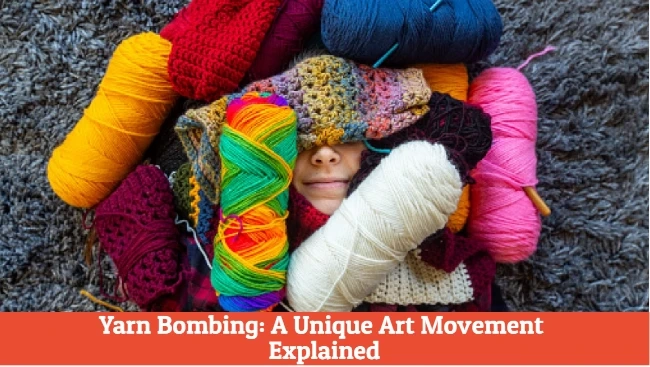Since the inception of human culture and civilization, art and literature held a central place in shaping the ideas and actions of human societies. Even in the day of hunter-gatherers and cave colonies, men were fascinated by the words and images and the meanings they carry.
From the renaissance onwards, art made a huge impact on the modern world, in some sense, it was the rationale behind the origin of the modern world. At the forefront of this metamorphosis were the artists and creators. There were different schools of thought that worked together, even against each other sometimes, to explore unchartered waters in the human minds and bodies.
Painters took the lead and created masterpieces that still inspire awe in the eyes of beholders. The evolution of art in general and painting, in particular, made it relatable to the common man.
Like every evolutionary thing, art has gone from one movement to another, or more precisely, one focus to another. In modern times, yarn bombing has taken the fascination of the public.
If you are wondering what this is, here is the introduction of this guerilla knitting art movement.
An Introduction To Yarn Bombing
In essence, yarn bombing is a combination of street art, graffiti, and activism. It relates to the apparently “cute” and soothing elements of knitting and crocheting, and make them stand head to head with the aggressive and revolutionary ideas of guerilla warfare and civil disobedience. The final statement comes lends elements from graffiti by seemingly “bombing” public objects and places with hand-knitted items and articles.
Yarm bombing or guerilla knitting uses both small and large elements from its surroundings and make them stand out to draw attention which otherwise they would not get. So, the most common places that get this induced attention are tree branches, public pipes, etc. Or the game takes place at a much higher scale and the bombers target things that already draw attention. By bombing, they grab all the momentum for the cause. The mammoth objects that get tagged can be buses, stairs, statues. There are even rare cases where a tank was yarn bombed!
It certainly deserves credit on being getting noticed.
The ultimate goal of the workers and yarn bombers working for the cause is to make a statement to make their voices heard in the policy-making halls. They tinker with the nature of things by making them look something else.
So, it is all good and effective, but if you know when did it start, read on to know more exciting things about this unique and fantastic art movement!
Of course, at first, the idea was solely to reclaim sterile everyday things and make them come close to us emotionally. It was like the idea of appreciating everything we have for what it is and the value it adds to our lives.
Magda Sayeg (Knitta Please)
Many things are discovered or come into existence by accidents, or go way beyond the expectations of the creators. The same goes true for this exotic art movement.
It started around 2005 in the US. A Houston-based woman, named Magda Sayeg, created her first yarn bomb artwork by putting some knitting on her doorknob. It was not her intention to make a political or even social statement by doing so. She only did it to amplify the importance of something that she saw every day without realizing its importance. Also, she wanted to give a warm and cozy feel to the door to welcome her guests and visitors.
Things would have been ended in some parallel universe, but this was not it here. Soon, this small and seemingly innocent gesture became an avalanche and got phenomenal notice and mentioning. This made her a celebrity and she started to receive positive feedback from people from all walks of life.
It is funny to note that Magda would be the first one to admit that she did not comprehend the influence and force of a “knitted” door handle. It turned out to be an art movement that changed the whole landscape of how art is conceived and performed. It changed her life, certainly, and the movement gained momentum and became international.
Knitta Please!
After that, she commenced a group of like-minded knitters. It was called “Knitta Please”. There was one thing they all had in common that make them stick to each other – beautifying public places.
If you are still wondering what was her intentions to knit the doorknob of her house, it was nothing but to personalize an urban article that saw every day and put it in another perspective by dressing it.
For some people, it seems natural and comprehensible, to dress things up to make them more functional or dress them, just for the sake of it. A tea-cozy is the prime example of dressing things up to enhance their functionality.
But there was another group that thought this absurd and non-sense. They concur with the idea of cozy and a tea-pot, but it was too much for them to have a doorknob knitted.
The answer that Magda gave them: Well, why not?
Development
After ball-rolling positive feedback from people in the neighborhood and abroad, it was only natural for Magda to take a step out of her house, and she did. After some time, she targeted a “STOP” signboard near her house and dress it in the yarn of beautiful patterns and vibrant colors.
It was supposed to be not a big deal, as she had thought.
In reality, it caused a public commotion. People started to stop on that “STOP” sign and wonder over the idea of putting knitting on a board. They even took pictured and shared with people all around the world. It was a unique thing but it asked all the right questions:
Who would put the yarn on a sign pole? Why would someone do that kind of thing? Is that a joke?
Read more about Knitting



